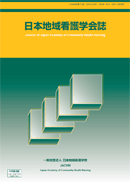Volume 16, Issue 3
Displaying 1-10 of 10 articles from this issue
- |<
- <
- 1
- >
- >|
-
Article type: Article
2014 Volume 16 Issue 3 Pages 4-12
Published: March 31, 2014
Released on J-STAGE: April 20, 2017
Download PDF (1080K) -
Article type: Article
2014 Volume 16 Issue 3 Pages 13-21
Published: March 31, 2014
Released on J-STAGE: April 20, 2017
Download PDF (1141K) -
Article type: Article
2014 Volume 16 Issue 3 Pages 22-31
Published: March 31, 2014
Released on J-STAGE: April 20, 2017
Download PDF (1266K) -
Article type: Article
2014 Volume 16 Issue 3 Pages 32-40
Published: March 31, 2014
Released on J-STAGE: April 20, 2017
Download PDF (970K) -
Article type: Article
2014 Volume 16 Issue 3 Pages 41-52
Published: March 31, 2014
Released on J-STAGE: April 20, 2017
Download PDF (1309K) -
Article type: Article
2014 Volume 16 Issue 3 Pages 53-64
Published: March 31, 2014
Released on J-STAGE: April 20, 2017
Download PDF (1497K) -
Article type: Article
2014 Volume 16 Issue 3 Pages 65-74
Published: March 31, 2014
Released on J-STAGE: April 20, 2017
Download PDF (1195K) -
Article type: Article
2014 Volume 16 Issue 3 Pages 75-81
Published: March 31, 2014
Released on J-STAGE: April 20, 2017
Download PDF (1016K) -
Article type: Article
2014 Volume 16 Issue 3 Pages 82-89
Published: March 31, 2014
Released on J-STAGE: April 20, 2017
Download PDF (1031K) -
Article type: Article
2014 Volume 16 Issue 3 Pages 90-97
Published: March 31, 2014
Released on J-STAGE: April 20, 2017
Download PDF (974K)
- |<
- <
- 1
- >
- >|
